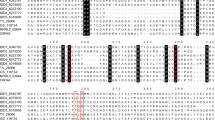Abstract
The white rot basidiomycete Phanerochaete chrysosporium metabolized dihydroanisoin (1,2-dianisylethane-1,2 diol) in low nitrogen stationary cultures, conditions under which the ligninolytic system is expressed. Anisyl alcohol was isolated as a metabolic product indicating an initial diol bond cleavage of the substrate. Use of 3H-labeled dihydroanisoin (1,2-dianisylethane-1,2-diol-1,2 3H) indicated that the diol bond was cleaved directly, yielding anisyl aldehyde as the initial product. The metabolically stable ketol anisoin was shown not be an intermediate in the metabolism of dihydroanisoin. The diol cleavage reaction was dependent on the concentration of molecular oxygen but O2 could be replaced by H2O2 under some conditions. The cleavage reaction was inhibited by exogenously-added tyrosine2-Cu2+ complex (TCC). The appearance of the fungal diol cleavage system parallels the appearance of the ligninolytic system under a variety of physiological conditions. In addition, preincubation of ligninolytic cultures with 2.5 mM l-glutamate represses both the ligninolytic and the diol cleavage activities.
Similar content being viewed by others
Abbreviations
- DHA:
-
Dihydroanisoin
- GLC:
-
gas liquid chromatography
- TLC:
-
thin layer chromatography
- TMS:
-
trimethylsilyl
References
Charalampous FC, Lyras C (1957) Biochemical studies on inositol. IV. Conversion of inositol to d-glucuronic acid by rat-kidney extracts. J Biol Chem 228:1–13
Constantopoulos G, Carpenter A, Satoh PS, Tchen TT (1966) Formation of isocaproaldehyde in the enzymatic cleavage of cholesterol side chain by adrenal extract. Biochemistry 5:1650–1652
Crawford RL (1981) Lignin biodegradation and transformation. Wiley-Interscience, New York
Crawford RL, Robinson LE, Foster RD (1981) Polyguaiacol: A useful model polymer for lignin biodegradation research. Appl Environ Microbiol 41:1112–1116
Dorfman LM, Adams GE (1973) Reactivity of the hydroxyl radical in aqueous solutions. Natl Std Ref Data Service, Nat Bur Std 46:1–59
Enoki A, Gold MH (1982) Degradation of the diarylpropane lignin model compound 1-(3′,4′-diethoxyphenyl)-1,3-dihydroxy-2-(4″-methoxyphenyl)-propane and derivatives by the basidiomycete Phanerochaete chrysosporium. Arch Microbiol 132:123–130
Enoki A, Goldsby GP, Gold MH (1980) Metabolism of the lignin model compounds veratrylglycerol-β-guaiacyl ether and 4-ethoxy-3-methoxyphenylglycerol-β-guaiacyl ether by Phanerochaete chrysosporium. Arch Microbiol 125:227–232
Enoki A, Goldsby GP, Gold MH (1981a) β-Ether cleavage of the lignin model compound 4-ethoxy-3-methoxyphenylglycerol-β-guaiacyl ether and derivatives by Phanerochaete chrysosporium. Arch Microbiol 129:141–145
Enoki A, Goldsby GP, Krisnangkura K, Gold MH (1981b) Degradation of the lignin model compounds 4-ethoxy-3-methoxyphenylglycol β-guaiacyl and vanillic acid ethers by Phanerochaete chrysosporium. FEMS Microbiol Lett 10:373–377
Fenn P, Choi S, Kirk TK (1981) Ligninolytic activity in Phanerochaete chrysosporium: Physiology of suppression by NH +4 and l-glutamate. Arch Microbiol 130:66–71
Gold MH, Cheng TM (1978) Induction of colonial growth and replica plating of the white rot basidiomycete Phanerochaete chrysosporium. Appl Environ Microbiol 35:1223–1225
Hall PL (1980) Enzymatic transformations of lignin. Enzyme Microb Technol 2:170–176
Hanson KR, Havir EA (1970) l-Phenylalanine ammonia-lyase. IV. Evidence that the prosthetic group contains a dehydroalanyl residue and mechanism of action. Arch Biochem Biophys 141:1–17
Kashiwagi K, Dafeldecker WP, Salhanick H (1980) Purification and characterization of mitochondrial cytochrome P-450 associated with cholesterol side chain cleavage from bovine corpus luteum. J Biol Chem 255:2606–2611
Keyser P, Kirk TK, Zeikus JG (1978) Ligninolytic enzyme system of Phanerochaete chrysosporium: Synthesized in the absence of lignin in response to nitrogen starvation. J Bacteriol 135:790–797
Kirk TK, Schultz E, Connors WJ, Lorenz LF, Zeikus JG (1978) Influence of culture parameters on lignin metabolism by Phanerochaete chrysosporium. Arch Microbiol 117:277–285
Kutsuki H, Enoki A, Gold MH (1983) Riboflavin-photosensitized oxidative degradation of a variety of lignin model compounds. Photochem Photobiol 37:1–7
Laskowsky P, Chen C (1980) Bond cleavage of diethylstilbesterol vicinal diol by a rat liver enzyme. Arch Biochem Biophys 202:318–319
Martis JB, Brown GM (1970) The biosynthesis of folic acid. XI: Purification and properties of dihydroneopterine aldolase. J Biol Chem 245:3015–3025
Nakatsubo F, Kirk TK, Shimada M, Higuchi T (1981a) Metabolism of a phenylcoumaran substructure lignin model compound in ligninolytic cultures of Phanerochaete chrysosporium. Arch Microbiol 128:416–420
Nakatsubo F, Reid ID, Kirk TK (1981b) Involvement of singlet oxygen in the fungal degradation of lignin. Biochem Biophys Res Commun 102:484–491
Reid ID, Seifert KA (1980) Lignin degradation by Phanerochaete chrysosporium in hyperbaric oxygen. Can J Microbiol 26:1168–1171
Richter C, Azzi A, Weser U, Wendel A (1977) Hepatic microsomal dealkylations: Inhibition by a tyrosine copper(II) complex provided with superoxide dismutase activity. J Biol Chem 252:5061–5066
Sarkanen KV (1971) Precursors and their polymerization. In: Sarkanen KV, Ludwig CH (eds) Lignins: occurrence, formation, structure and reactions. Wiley-Interscience, New York, pp 95–195
Shimada M, Nakatsubo F, Higuchi T, Kirk TK (1981) Biosynthesis of the secondary metabolite veratryl alcohol in relation to lignin degradation in Phanerochaete chrysosporium. Arch Microbiol 129:321–324
Shimada M, Higuchi T, Katayama T (1982) Xenobiotic aspects of lignin degradation in white rot fungi. In: Proceedings of TAPPI Research and Development Division Conference. Asheville, North Carolina, pp 241–248
Weinstein DA, Krisnangkura K, Mayfield MB, Gold MH (1980) Metabolism of radiolabelled β-guaiacyl ether linked lignin dimeric compounds by Phanerochaete chrysosporium. Appl Environ Microbiol 39:535–540
Author information
Authors and Affiliations
Rights and permissions
About this article
Cite this article
Shimada, M., Gold, M.H. Direct cleavage of the vicinal diol linkage of the lignin model compound dihydroanisoin by the basidiomycete Phanerochaete chrysosporium . Arch. Microbiol. 134, 299–302 (1983). https://doi.org/10.1007/BF00407806
Received:
Accepted:
Issue Date:
DOI: https://doi.org/10.1007/BF00407806




